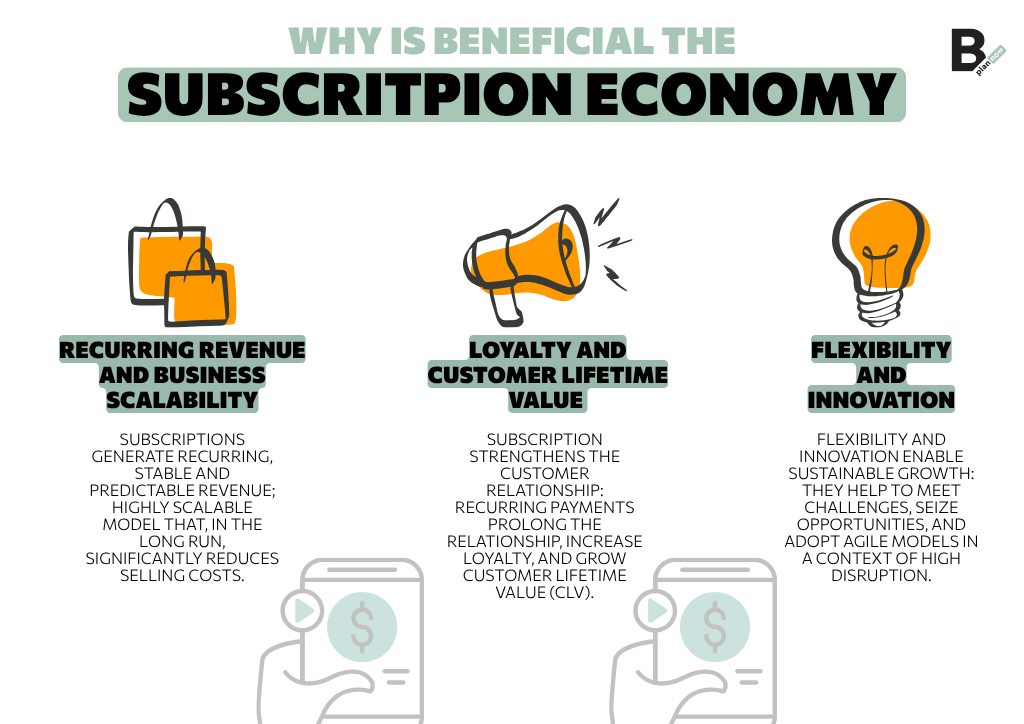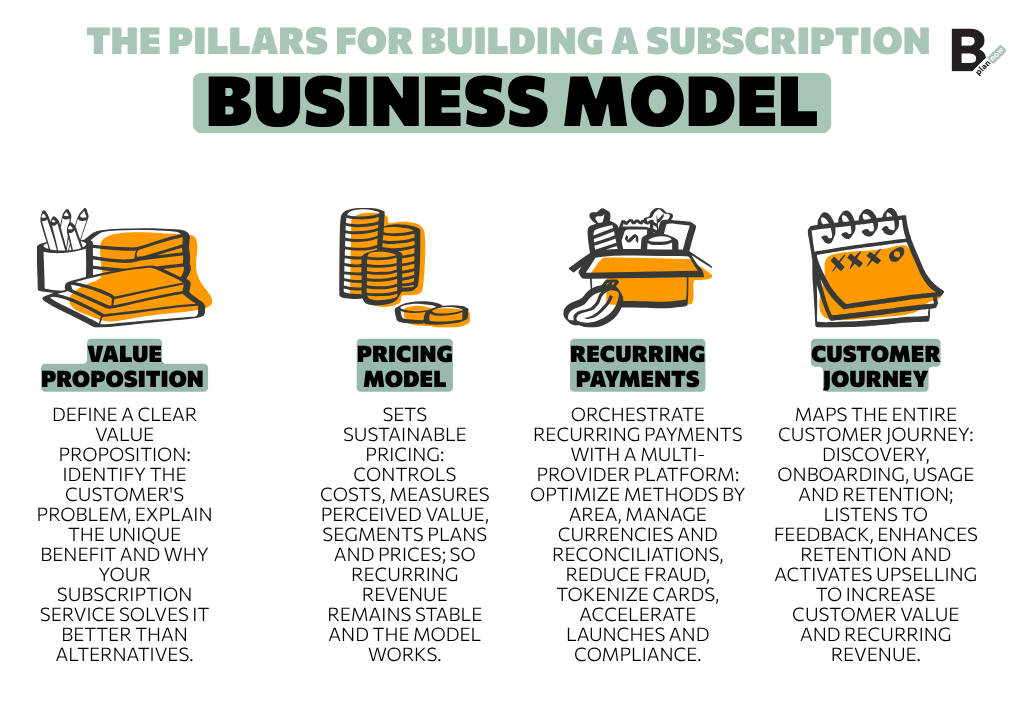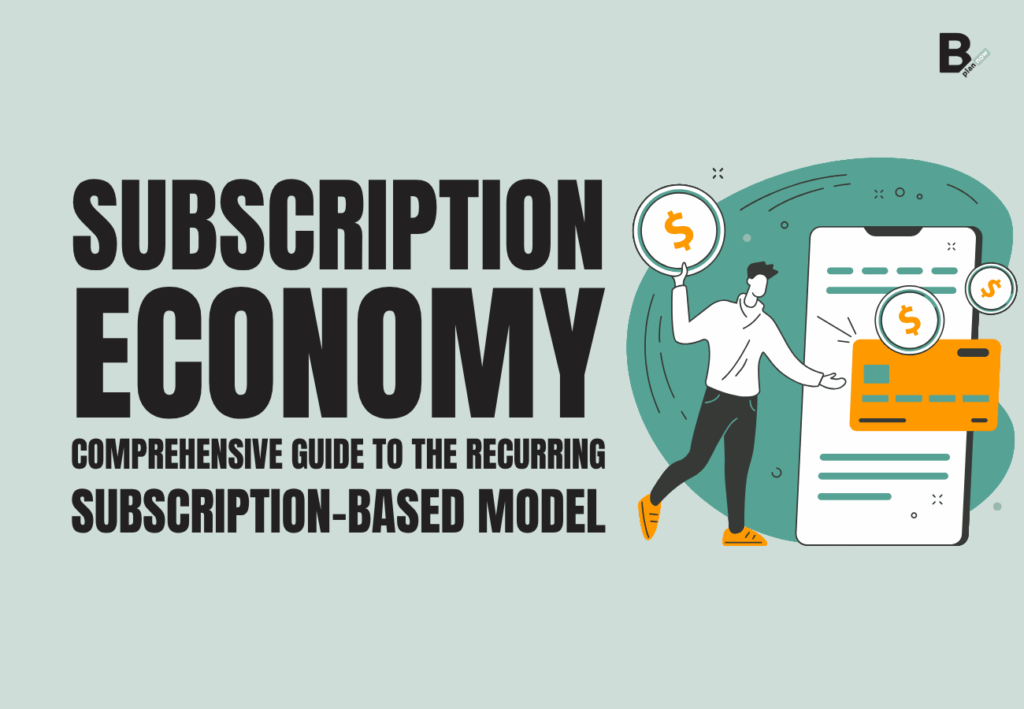The Subscription Economy is a strategic opportunity for startups (but also for traditional businesses). If you want to seize it, you need to thoroughly understand this business model based on recurring subscriptions. Don’t panic, you’re in the right place: this guide contains a precise explanation of what the Subscription Economy is, a list of the benefits it offers to startups, and a step-by-step description of how to build a subscription business model that can prove to be (truly) effective. And that’s not all: you’ll also find a dedicated focus on churn rate, customer loyalty, and sustainability.
What is the Subscription Economy and why is it growing
The birth of the definition of Subscription Economy dates back to 2007, when Tien Tzuo, CEO of Zuora, coined this particular expression to describe the business model centered on recurring payments adopted by various companies, including many operating in the streaming services sector.
Over the years, the Subscription Economy has transcended the boundaries of digital services, ending up revolutionizing other fields as well, where consumer goods, industrial products, and financial products dominate.
From digital services to physical goods: the evolution of the model
The Subscription Economy — by now it should be clear to you — is a business model that involves companies offering their customers the opportunity to subscribe at a regular rate (generally on a monthly or annual basis) and thus continuously access a service (or a product).
In recent years, this practice has become increasingly widespread, with consumers more and more interested in benefiting from flexible and personalized purchase experiences.
As already mentioned, the Subscription Economy does not refer only to digital services: as further testimony to this, it’s enough to cite the survey conducted by Dynata in 2022, which revealed great interest also in other product sectors, among which food, personal care, home, and clothing stood out.
A revolution in consumption driven by data and personalization
We have already mentioned the importance for consumers of being able to experience personalized and flexible purchase experiences.
There is, however, another aspect you must consider if you want to comprehensively analyze this revolution in consumption: it’s the importance of data. This business model, in fact, gives rise to a regular, predictable, and shapeable revenue stream if those who adopt it make wise use of the abundant data that a solid customer relationship makes available to companies.
Why the Subscription Economy is advantageous for startups
The Subscription Economy can be an extremely advantageous solution for startups. And there are various reasons for this.

Recurring revenues and business scalability
The first benefit is linked to the already mentioned possibility of obtaining recurring revenues, which, as such, are more stable and predictable. To this is added the scalability that characterizes this particular business model. You must also consider that, in the long term, the Subscription Economy reduces sales costs.
Customer loyalty and Customer Lifetime Value (CLV)
Customer loyalty is one of the cardinal principles of subscription business models because success revolves around the customer relationship. By its very nature, the subscription creates a stronger relationship between the customer and the company, with the relationship lasting longer over time thanks to recurring payments and the Customer Lifetime Value (CLV, the customer’s life cycle value) being extended.
Flexibility and innovation: strategic levers for new businesses
Flexibility and innovation are crucial factors for new businesses because they allow them to grow sustainably, better facing challenges and seizing opportunities sooner, especially in a moment of strong disruption like the current one that requires the adoption of agile models as a priority.
The pillars for building a subscription business model
To build an effective subscription business model, you must start from three pillars.

Value proposition and pricing model
The first key element of the subscription business model is the value proposition: to define it, you must identify the problem your service or product aims to solve and the unique benefit it can ensure to those who decide to purchase it.
Another decisive factor is the pricing model: the subscription model ensures a recurring and stable revenue stream, but for this to be possible, it’s essential to maintain control over costs and understand what the real value perceived by customers is.
Recurring payments: orchestration and security
The management of recurring payments that characterize the subscription business model is complex: on one hand, there are the rules defined by payment circuits or SEPA (regarding bank account debits), on the other hand, there are the specific needs of companies. The complexity, moreover, concerns aspects such as different currencies internationally and the crediting and reconciliation processes.
To manage everything optimally, you can use a multi-provider payment orchestration platform. It allows processing transactions through the best provider and the most suitable payment method, based on geographical area and preferences indicated by the target, and helps reduce time to market.
The benefits of using a payment orchestration platform are also linked to the security domain, since it detects and prevents fraud and analyzes transactions in real time, identifying any suspicious activities. Equally important, then, is the tokenization of payment card data: sensitive card information is replaced with a unique token, thus securing the actual data.
Customer Journey: onboarding, retention, and up-selling
Those who adopt a subscription business model — by now it should be clear to you — must establish solid relationships with their customers and understand what they most appreciate about the service/product and how they would like it to be improved.
Therefore, it’s essential to have full awareness of the Customer Journey, that is, the path the customer takes from discovering the service/product through onboarding and up to its use and, then, to loyalty.
Particular attention should be dedicated to retention strategies, and implementing upselling techniques can be useful, in order to build customer loyalty while simultaneously increasing transaction value.
Churn rate: what it is and how to reduce it
The Churn rate, also known as attrition rate, is a fundamental metric that, if you want to adopt a subscription business model, you certainly cannot overlook. Specifically, it indicates the percentage of customers who decide to stop using the service/product in a defined time period.
Strategies to lower the attrition rate
It goes without saying that the attrition rate must be kept low. To achieve this goal, first of all, focus on the reasons that may lead a customer to stop using the service/product: they are various and range from price to competition, from user experience to communication, including customer support.
In addition to investigating (and intervening on) the causes of Churn rate, to lower the attrition rate, focus attention on your best customers (i.e., the most profitable ones) and dedicate yourself to them, making them feel special.
Key KPIs to monitor
In addition to the Churn rate, there are, however, other marketing KPIs that are essential to monitor: one of these is the Customer Acquisition Cost (CAC), the Customer Lifetime Value (CLV), and the Monthly Recurring Revenue (MRR).
Subscription Economy and sustainability: a new paradigm
There is another fundamental factor to consider when talking about Subscription Economy: it’s sustainability.
From ownership to access: less waste, more reuse
The possibility of accessing a service/product without purchasing and physically owning it, first of all, reduces waste and facilitates the reuse of that same service or product.
Subscriptions to capital goods and second-hand economy
Companies are encouraged to produce high-quality and durable services and capital goods, which can thus be used long-term by the customer and change hands, feeding the second-hand economy.
Why the subscription model can favor the circular economy
The Subscription Economy approach stands in stark contrast with what is, instead, the traditional way of thinking and acting based on product sales: generally, in fact, companies are used to producing low-quality goods or, in any case, with a short life, so as to push the customer to purchase new products more frequently. The subscription model, therefore, favors the circular economy, reducing the amount of waste and negative environmental impact.
Subscription Economy: a strategic opportunity for startups and traditional businesses
Before concluding this guide dedicated to the Subscription Economy, it’s appropriate to recap the reasons why this business model represents a valuable strategic opportunity for startups, as well as for traditional businesses.
The Subscription Economy manages to capture and capitalize on the enormous value of customer relationships through subscriptions and allows for easier prediction of revenue flow and growth, but also how the perception of value changes over time for customers.
There is one last aspect to remember: in the long term, subscription-based models reduce sales costs: customer relationships, in fact, are no longer measured based on one-time transactions. Quite the opposite. Remember the words of Robbie Kellman Baxter:
“In the new world of subscription, the sale is just the beginning of the relationship.”
Do you want to read all the articles related to the stage your startup is in?


